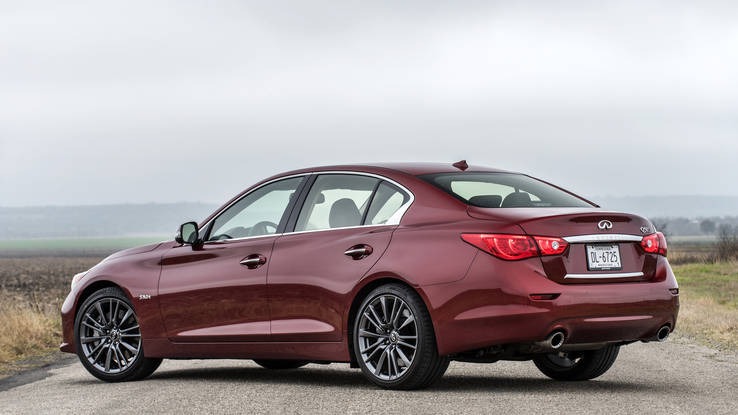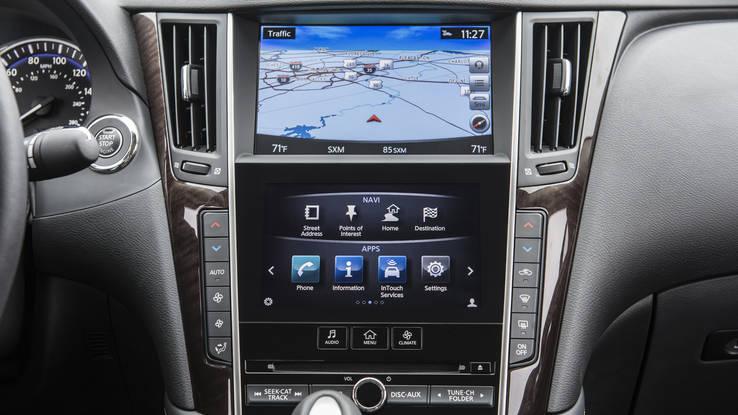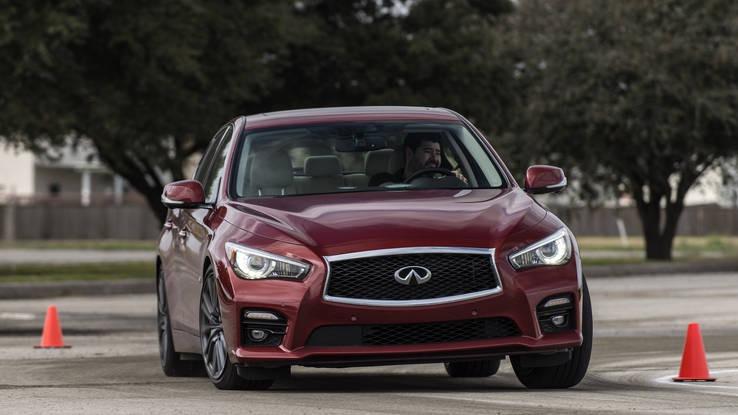With a name that long, it must be good
Infiniti’s Q50 sedan started life 26 years ago — of course, then it was known as the G-Series. Over the course of two and a half decades, it’s shared parts with Z cars, been called a Skyline and even hosted the driveline from a GT-R. Now, as it’s approaching a midlife crisis, the Q50 is shedding even more of its past: the venerable VQ engine series. No longer will the throaty 3.7-liter V6 feed exhaust notes to the massive tips underneath the rear bumper — and we couldn’t be happier.
Infiniti took what Nissan learned with its VR38DETT 3.8-liter V6 and applied that knowledge to the VR30DDTT 3.0-liter V6 that will soon sit under the hood of Infiniti sports cars for years to come.

Photos from the 2016 Infiniti Q50 3.0t Red Sport first drive.
Aside from a different heart, the Q50 rides on a new electronically controlled suspension, which is adjusted through the drive selector switch. That’s a big change from the traditional shocks and springs on the outgoing models, and it allows the suspension to firm up when you want but stay reasonably comfortable as you’re stretching the car’s legs across the country.
One place that hasn’t changed is the interior. The same dual infotainment screens display navigation and media information on top, while the lower, touch-sensitive screen controls them.

Photos from the 2016 Infiniti Q50 3.0t Red Sport first drive.
What’s it like to drive?
Under the hood rests the latest piece of high-tech Infiniti wizardry — the VR30DDTT. While this VR engine will come in multiple tunes, the one in this tester is the 400-hp Red Sport version. More specifically, the twin-turbocharged 3.0-liter DOHC V6 makes 400 hp at 6,400 rpm and 350 lb-ft of torque from 1,600 rpm all the way to 5,200 rpm.
Now the bad news: The only available transmission is a seven-speed automatic. Infiniti tried to make the transmission sportier with downshift rev matching and dynamic driving modes, but it’s not nearly as quick as today’s dual-clutch setups. Magnesium paddle shifters are mounted to the steering column.
Although the Q50 will be available with all-wheel drive, there weren’t any for us to test. You’ll probably want to spring for it though, as the factory equipped 19-inch rear Dunlop 265/35 run-flats don’t like to bite on hard launches. Sportier summer rubber will be an available option, and if you don’t spring for the all-wheel drive you’ll want those better tires.

Photos from the 2016 Infiniti Q50 3.0t Red Sport first drive.
Launch grip aside, we feel this Infiniti handles the remaining driving duties well. A double-wishbone front suspension helps the slightly narrower 245/40 rubber stay planted to the ground while sprinting around an autocross course. In back, a multilink does most of the work. The adjustable suspension firms nicely in sport mode but is mostly pleasant in the comfort setting.
Infiniti said it made some changes to the Q50’s handling in the Direct Adaptive Steering system, but we hopped in both the previous and current gen and didn’t find noticeable improvement. Other than renaming the different steering modes, the system works about the same. The old setup received some flack, but under the heaviest settings we thought both systems worked well. The biggest difference with the revised DAS is apparent in standard and light — the old system had a wimpy feel, while the new one seems more confident, despite the easier-to-move wheel.

Photos from the 2016 Infiniti Q50 3.0t Red Sport first drive.
Do I want it?
If you’re looking for a luxury sedan, it would be hard to not give the Infiniti Q50 a drive. Pricing hasn’t officially been released, but Infiniti says this 400-hp contender should be available in the $ 40,000 range.
Does it stand up to BMW’s 340i? It lacks a stick shift, so if you like rowing your gears, the Infiniti won’t do it for you. But you do get 80 more hp and sheetmetal that’ll stand out in a crowd.


























